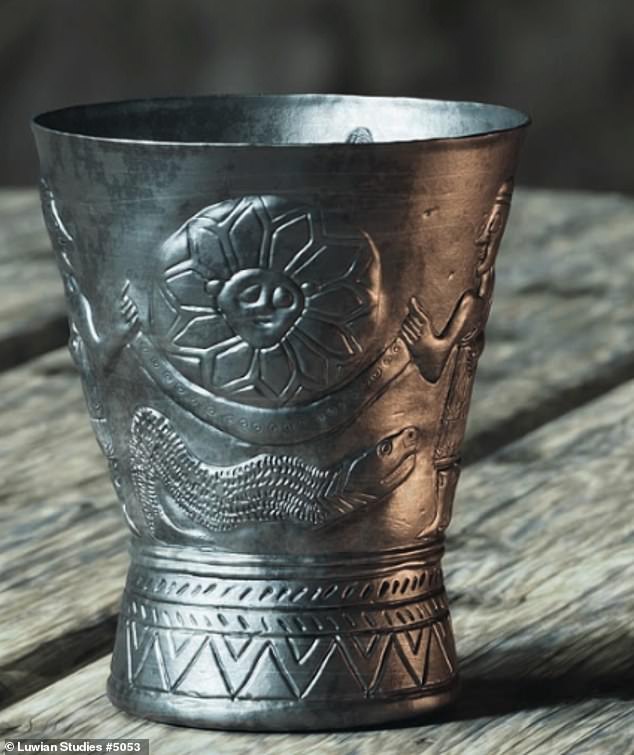A new analysis of a 4,300-year-old silver goblet has identified the earliest known visual depiction of creation, showing themes that closely align with the Bible’s Book of Genesis.
The artifact, known as the Ain Samiya goblet, stands just three inches tall and is decorated with intricate images of snakes, chimeras, gods, celestial bodies and a mysterious ‘boat’ of light.
Discovered in 1970 in the Judean Mountains of the West Bank, the cup has been on display at the Israel Museum for decades, though its full meaning has only now come to light.
A recent study has revealed that the goblet’s scenes depict the cosmos before its formation, representing chaos, and the cosmos after order was established.
Dr Eberhard Zangger, president of the Luwian Studies Foundation and one of the study’s authors, explained that the story illustrated on the goblet evolved into different versions over time, including the Babylonian Enuma Elish and the biblical Genesis creation narrative.
‘The left side of the goblet represents the chaotic state of the cosmos before creation, while the right side shows the ordered universe after,’ Zangger said.
‘This artifact gives us an incredibly detailed picture of how people in 2300 BC imagined the cosmos before creation.’
The parallels to the Bible are striking, as Genesis 1:1-4 reads: ‘When God began to create heaven and earth, the earth being unformed and void… God said, ‘Let there be light,’ and there was light. God saw that the light was good, and God separated the light from the darkness.’

The artifact, known as the Ain Samiya goblet, stands just three inches tall and is decorated with intricate images of snakes, chimeras, gods, celestial bodies and a mysterious ‘boat’ of light
Zangger noted that while written references to these creation concepts are ancient, finding a visual depiction this early is extremely rare, making the Ain Samiya goblet a unique window into the ancient Near Eastern understanding of the universe and its beginnings.
The artifact, found in a burial pit, was found near the Palestinian village of Ain Samiya, where archaeologists had unearthed hundreds of ancient graves.
‘The purpose of the burial object was to connect the soul of the deceased with the journey of the sun, ultimately to heaven,’ reads the study published in the peer-reviewed Journal of the Ancient Near Eastern Society “Ex Oriente Lux.’
The goblet features two vertical mythological scenes, each occupying roughly half of its frieze.
The first, often described as the left scene, shows a chimera with a human torso and twin bull lower bodies, holding stylized palm fronds, accompanied by an upright snake.
This scene represents the chaotic state of the universe before order was established.
The second scene, on the right, depicts two anthropomorphic figures holding a crescent-shaped object topped with an eleven-petaled rosette, with a large snake between them.
Researchers interpreted the crescent as the ‘boat of light,’ symbolizing the sun and moon traveling across the sky and this scene illustrates the cosmos after order was imposed.

A recent study has revealed that the goblet’s scenes depict the cosmos before its formation, representing chaos, and the cosmos after order was established (artist’s impression)
When the goblet was first unearthed, scholars believed the imagery depicted scenes from the ‘Enuma Elish,’ a Babylonian creation myth documented on clay tablets dating to the late 2nd millennium BC.
The Enuma Elish is an ancient Babylonian creation myth written on seven clay tablets that tells the story of the cosmos’s origin and the rise of the god Marduk.
However, Zangger told The Times of Israel that the timeline had to be revisited, suspecting it was far older than first documented.
‘Because there was so much pottery [in the burial], it’s pretty obvious that the grave is from about 2200 BC, while if we look at the iconography, we find a resemblance to that of 2300 BC,’ he explained.
‘So the time discrepancy between the production and the deposition is probably not more than 100 years.’
The study concluded that the design mirrors that of Early Dynastic III, a culture in Mesopotamia dating between 2900 and 2350 BC, which developed writing and the formation of the first cities and states.
‘However, the production of the cup may have taken place in northern Syria,’ researchers shared.
‘The designer of the depiction achieved a great feat by adding certain new components to the long-standing narratives about the creation of the world, thus creating a unique vessel. From Syria, the goblet reached the southern Levant along well-traveled caravan routes.
‘There, around 2200 BC, it found its final resting place in a tomb.’
